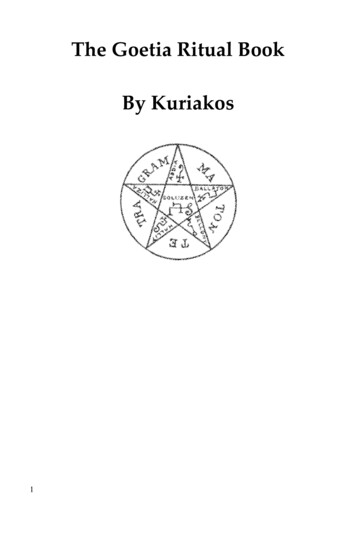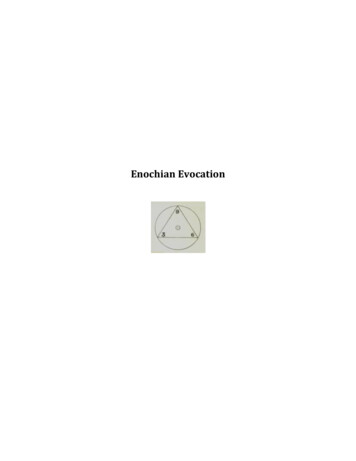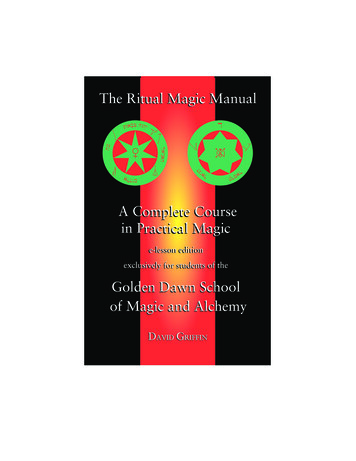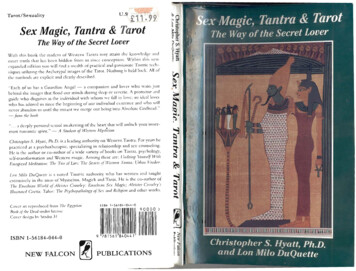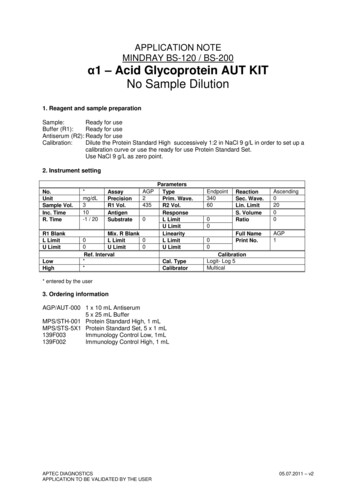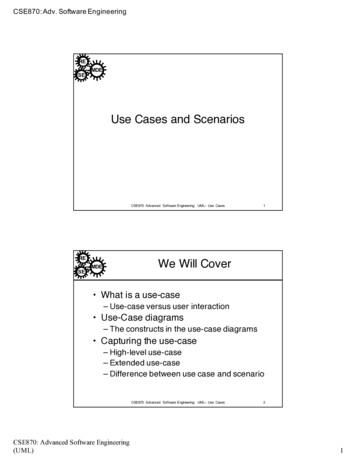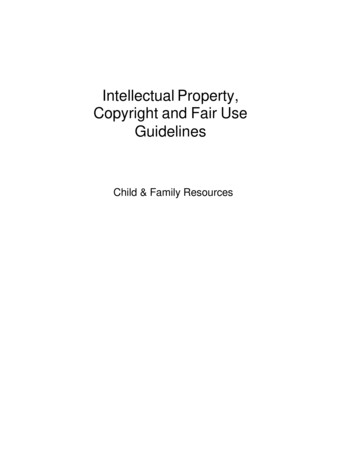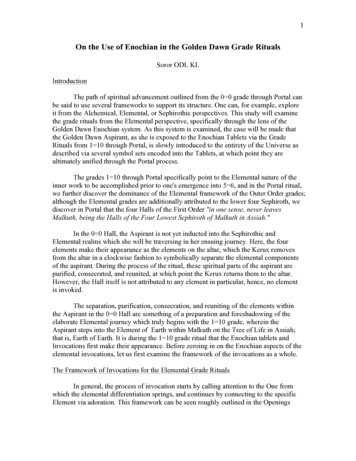
Transcription
1On the Use of Enochian in the Golden Dawn Grade RitualsSoror ODL KLIntroductionThe path of spiritual advancement outlined from the 0 0 grade through Portal canbe said to use several frameworks to support its structure. One can, for example, exploreit from the Alchemical, Elemental, or Sephirothic perspectives. This study will examinethe grade rituals from the Elemental perspective, specifically through the lens of theGolden Dawn Enochian system. As this system is examined, the case will be made thatthe Golden Dawn Aspirant, as she is exposed to the Enochian Tablets via the GradeRituals from 1 10 through Portal, is slowly introduced to the entirety of the Universe asdescribed via several symbol sets encoded into the Tablets, at which point they areultimately unified through the Portal process.The grades 1 10 through Portal specifically point to the Elemental nature of theinner work to be accomplished prior to one's emergence into 5 6, and in the Portal ritual,we further discover the dominance of the Elemental framework of the Outer Order grades;although the Elemental grades are additionally attributed to the lower four Sephiroth, wediscover in Portal that the four Halls of the First Order "in one sense, never leavesMalkuth, being the Halls of the Four Lowest Sephiroth of Malkuth in Assiah."In the 0 0 Hall, the Aspirant is not yet inducted into the Sephirothic andElemental realms which she will be traversing in her ensuing journey. Here, the fourelements make their appearance as the elements on the altar, which the Kerux removesfrom the altar in a clockwise fashion to symbolically separate the elemental componentsof the aspirant. During the process of the ritual, these spiritual parts of the aspirant arepurified, consecrated, and reunited, at which point the Kerux returns them to the altar.However, the Hall itself is not attributed to any element in particular, hence, no elementis invoked.The separation, purification, consecration, and reuniting of the elements withinthe Aspirant in the 0 0 Hall are something of a preparation and foreshadowing of theelaborate Elemental journey which truly begins with the 1 10 grade, wherein theAspirant steps into the Element of Earth within Malkuth on the Tree of Life in Assiah;that is, Earth of Earth. It is during the 1 10 grade ritual that the Enochian tablets andInvocations first make their appearance. Before zeroing in on the Enochian aspects of theelemental invocations, let us first examine the framework of the invocations as a whole.The Framework of Invocations for the Elemental Grade RitualsIn general, the process of invocation starts by calling attention to the One fromwhich the elemental differentiation springs, and continues by connecting to the specificElement via adoration. This framework can be seen roughly outlined in the Openings
2prescribed by the Cypher Manuscripts (see accompanying charts; invocatory portions inred), and fleshed out in the various Golden Dawn redactions. The overall sequence is this:1) Declare Adoration of the God-Source of the Element; invoke Great Name. The 1 10version of this, as indicated by the 1 10 folio, is somewhat more elaborate than the otherthree.2) Move to the attributed quarter, facing the corresponding Tablet. Traditional redactionsinclude a verse here from Genesis 1:26-27, which appears to be somehow extrapolatedfrom a line that appears only in the 1 10 folio, and seems to read "gen ז . ו . "אק which is abit ambiguous. Be that as it may, the purpose seems to be to evoke a creation myth. TheOSOGD redactions keep the spirit of the segment but replace the Biblical passage withdifferent passages that are essentially Qabalistic, and harmonious with the correspondingElement and Hall.3) Invoke the Spirits of the Element by the following Hebrew Names:A) The Sephirothic God NameB) The God Name according to the Greater Pentagram attributionsC) The Archangel Name4) Invoke the Spirits of the Element by the Names and Letters of the correspondingEnochian Quadrangle:A) The Three Great NamesB) The King NameThe Enochian Tablets as introduced in the Elemental HallsThe Elemental Tablet represents the forces that the Aspirant is exposed to duringthe Hall, and its power is tapped via the Three Great Names. According to Zalewski, theElemental King is "the first ray that impregnates the aura" of the Aspirant, and alsocoordinates and directs the forces of the Tablet. The vibrational pitch of the Aspirant'saura is shifted in sympathy with the pitch of the Element, and thus, the Aspirant isintroduced to the spirits of the Element. In each Hall, the Aspirant is introduced directlyto the Tablet of the Hall in a manner that is an elaboration of these instructions of theCypher Manuscripts:1 10: SHEWS TABLET AS IN OLD MSS1 (includes drawing of a Tablet).2 9: SHOWS TABLET OF AIR3 8: SEE WATCH TOWER & WORDS EMPEH ARSEL GAIOL4 7: SHOWS FIRE TABLET SEE - OIP - TEAA - PEDOCE1According to Runyon, the MSS refers to Book H or Clavicula Tabularum Enochi, which is Westcott'sadaptation of Sloane MS 307, an anonymous 17th century manuscript for which the authorship appears tobe a source of some debate. This is essentially the source of the Golden Dawn Enochian system.
3The Cypher Manuscripts (and ensuing Grade rituals) seem to use "Tablet" and "WatchTower" interchangeably. Technically these refer to slightly different things: the Tabletsare the lettered grids containing the Names of spirits, whereas the Watch Towers refer toKelley's vision of the hierarchy of these spirits in a personified form, lining up in fourdirections within four castles in the shape of an equal-armed cross. An image based onthis vision, found in Casaubon's A True & Faithful Relation, is referred to as the GoldenTalisman.The Tablets are introduced cumulatively; that is, each Hall also contains theTablet(s) of the Hall(s) preceding it, though only the current Tablet is invoked andspecifically shown to the Aspirant. The Tablet or Watch Tower is described as one of theprinciple emblems of the Hall. As the Aspirant is introduced to the Tablet of the Hall, itselemental and directional attributions are named, and it is referred to as "one of the fourGreat Tablets of the Elements said to have been given to Enoch by the Great Angel Ave."The myth attributing the Tablets to Enoch appears to be derived from A True & FaithfulRelation, (an apt myth, since Enoch has been equated with Thoth-Hermes), and theCypher Manuscripts refer to אוה in the 1 10 opening. It is worth noting that אוה enumerates to 12, implying that the Tablets were given by the Zodiac, and thus byChokmah/Wisdom. 12 is also the sum of the letter Vau ( )וו , indicating the Hierophanticand trans-Abyssal nature of this transmission.The further division into sub-angles is briefly mentioned, which subdivides eachelement; for example, the Earth Tablet is divided into Air of Earth, Water of Earth, etc.This is followed by a mention of the innumerable names of spirits of the nature of thatelement to be found within that Tablet. Interestingly, the Cypher Manuscripts onlyindicate that the aspirant specifically be pointed out the Three Great Names during the3 8 and 4 7 rituals; not during the 1 10 or the 2 9. As with many things in the CypherManuscripts, it is unclear whether this is intentional or an oversight. The Stella Matutinarituals apparently assume this is an oversight, and point out the Names to the aspirant inall four Advancements. The OSOGD rituals do this as well, and also specifically pointout the King Names to the Aspirant during the 3 8 and 4 7, but not during the 1 10 orthe 2 9.Although Book H does attribute the four Tablets to the four cardinal points,nowhere in Book H or, apparently, in any of the surviving Dee & Kelley manuscripts, arethere any overt attributions of the quadrangles of the Great Table to the Elements.However, the Angel Ave strongly implies an Elemental nature contained in the Tabletswhen describing the categories of knowledge contained within them. According to BookH, the Tablets contain "all human knowledge," and as it applies to the Elements, "theknowledge of all elemental creatures amongst us, how many kinds there are, and for whatthey are created. Those that are in the Air, Water & Earth by themselves. The property ofFire, which is the secret Life of all things. But those more particularly." Additionally,according to A True & Faithful Relation, The Angel Ave proclaims that "The Angels ofthe 4 angles shall make the Earth open unto you, and shall serve your necessities fromthe 4 parts of the Earth." Although there is no such explicitly stated attribution, this bit
4of revelation sounds consonant with the 4 parts of Malkuth, which the Aspirant traversesthrough the Grades of the Outer Order.It is also interesting to note that Kelley's Golden Talisman vision does include 4colors in the form of cloths on the ground emerging out of the castles. Out of the East, ared cloth; out of the South, white; out of the West, green or pale green; out of the North,black. These are not overtly Elemental, but several sources, including Aurum Solis andDavid R. Jones, have linked these colors to Elemental and Zodiacal / Seasonalattributions via the 4 Horsemen of the Apocalypse. It is also possible to attribute thesedirections Alchemically (Red Lion; White Eagle; Green Lion; Black Dragon).Anatomy of an Enochian Tablet, According to the Golden DawnOutside of the implied elemental forces introduced to the aspirant in the elementalHall, implicit in the introduction are also a staggering quantity of other forces encodedinto each Tablet. The 6 Seniors pulled from the Great Central Cross, together with theKing, are attributed by the Golden Dawn to Planetary forces. The King is the Solar spirit,who comes in two flavors: merciful and severe. The way the two are distinguished is bythe last letter. According to A True & Faithful Relation:Ave: Thou hast Bataiva or Bataivh. You must take but one ofthem, either the A or the H. A, comiter, and H in extremis judiciis.In other words, the two central letters on the Tablet, indicating the end of the King Name,appear to be an either/or proposition. Thus it remains a 7-letter Name, as are the rest ofthe Seniors. Book H, however, does not mention this distinction, nor does it seem to carewhether the Name remains 7 letters with one or the other ending, or an 8-letter Namewith both. The Cypher Manuscripts indicate the usage of the 8-letter version quite clearlywith the King Names for the Air and Water Tablets; the Earth and Fire King names giveless clear indications. Nevertheless, the Golden Dawn has apparently been using the 8letter Name for all Tablets, covering both merciful and severe bases, since its inception.The same Great Cross also contains Tarot and Decanate attributions. Furthermore,each sub-angle contains a Calvary Cross of 10 squares each, and is consideredSephirothic. Not only are the sub-angles attributed to sub-elements, but also to the fourSuits of the Tarot, and to the four Letters of the Tetragrammaton. The four Calvary orSephirothic Crosses are thus further attributed to the four Qabalistic Worlds. The squaresabove the Calvary Crosses contain the names of Kerubic spirits, attributed to the Courtcards, who rule over the Servient spirits below. These spirits below the Crosses containmultiple attributions, including Zodiacal and Geomantic. Containing such flexibility inattributions, the Tablets could be seen as unifying centers for the entire complex ofsymbol sets used in the Halls. Furthermore, encoded into the Tablets are the 91 Parts ofEarth, which themselves link to the 30 Aethyrs; as such, these represent yet another lensthrough which one could theoretically access the entirety of all levels of consciousness.The 30 Aethyrs and 91 Parts can additionally be attributed to the Sephiroth on the Tree ofLife in the Four Worlds. Thus one can surmise that through the four Tablets introduced
5within the four Elemental Halls, the aspirant is exposed to an encoded package of severalsystems of symbolic representation of the entire Universe.On the Plethora of Versions of Enochian TabletsIt is interesting to note that the design of the Great Table from which the fourTablets were derived does not appear to be Dee & Kelley's original design. A strikinglysimilar design appears in multiple examples of encrypted pictorial religious poetry in delaudibus sanctae crucis, the work of a 9th century monk named Hrabanus Maurus. Anumber of these appear to be derived from this very familiar layout:
6There exist multiple versions of the Great Table. The two main versions from Dee& Kelley are:1. The Original Table given by Ave2. The Reformed Table given by RaphaelOutside of differences in letters, the main difference between the two is a rearrangementof the Quadrangles. Using Book H cardinal attributions, the differences in layout are thus:Original Table:Reformed Table:EASTNORTHEASTWESTSOUTHWESTNORTHSOUTHThe Reformed Table is the version most often used by Golden Dawn practitioners. Thereis at least some anecdotal consensus that it "works better" or "flows better" than theOriginal Table. Perhaps the Original is a "beta" version. Or perhaps it "flows better"because it aligns more precisely with other symbolic sets of attributions used by theGolden Dawn. In particular, the Reformed Table aligns perfectly with the Zodiac wheel:East 11th House / AquariusWest 8th House / ScorpioNorth 2nd House / TaurusSouth 5th House / LeoThis, in turn, gives us our Elemental attributions:East Aquarius AirWest Scorpio WaterNorth Taurus EarthSouth Leo Fire.which also aligns with the lower four points of the Pentagram as used by the GoldenDawn, additionally placing Spirit on top. The sub-angles of the individual Tablets followthe same elemental alignment. Now possessing elemental attributions, the Golden Dawnassigns its system of flashing colors to the Tablets, which were previously colorless.The Great Seals adorning the tops of the Tablets are sometimes referred to as theSpirit point. The Seal corresponds with the "One Trumpeter" of the Golden Talisman,thus heading the hierarchy that continues with the "Three Ensign Bearers," whocorrespond with the Three Great Names. As such, the Great Seal could probably beconsidered an emblem of the particular face of the One (or "God") that is reflected by thatTablet. Book H alludes to these Seals somewhat opaquely; they are referred to as "AngelOverseers" over the parts of the world as divided by cardinal direction. They are,however, addressed in some detail in the Concourse of the Forces.
7These Seals also connect the Tablets to the Heptarchic Enochian system.According to the Concourse of the Forces, the Seals are all taken from the Sigillum DeiAemeth. This is not, however, entirely clear. The Seal of the Eastern Tablet, which showsa letter "T" with 4 short rays on top (The Concourse of the Forces refers to these rays asYods), refers to the 4T at the top of the outer perimeter of the Sigillum. This 4T marksthe beginning point where seven God Names are derived from the outer perimeter, whichcan be attributed to the Planetary spheres. The Seal of the Northern Tablet is a simpleequal-armed cross which appears on a 7x7 table containing the Names of the sevenPlanetary Archangels, along with another set of seven God Names which arraythemselves on the outer heptagonal portion of the Sigillum. The equal-armed cross isplaced on this heptagon as well. The Seal of the Western Tablet is an equal-armed crossadorned with the letters b, b and the numbers 4 and 6. It is found on one of a set ofplanetary talismans called the Ensigns of Creation, which are used with the Sigillum;specifically, it is located on the Ensign of Mercury. The Seal of the Southern Tablet is alittle circle with 12 rays. Its origin, however, is unclear. Due to the 12 rays, it is temptingto give this Seal a Zodiacal attribution. Overall, however, one can hypothesize that due tothe Heptarchic nature of the Sigillum, through the Seals, the Aspirant is given a link tothe Planetary forces.The Golden Dawn system further links these Seals with the Sigillum Dei Aemethvia the Names of "Supreme Elemental Kings," which use the symbolism of the Sealsthemselves to yield Names from the Sigillum. These are not the same as the SolarElemental Kings who spiral out from the center of the Tablet, being also Planetary innature; but rather, these are considered Kings of the entire Tablet, "drawn forth" from theSeals, and purely Elemental in nature. Finally, like the Tablets, the Seals are also depictedin color by the Golden Dawn, corresponding with the system of elemental attributions asdescribed above.Out of Dee & Kelley's Tables came other slightly different versions from varioussources. Most, if not all, commonly used Tables feature the Reformed arrangement ofquadrants, but varying letters. An additional complication surfaces if one attempts toreconstruct the Table based on the names of the 91 Parts of Earth as given by Nalvage,for the arrangements of letters on neither the Original nor Reformed Tables align exactlywith the 91 Parts of Earth as given. The various attempts to rectify the Tables with the 91Parts, beginning with Dee himself, led to the creation of Tablets with multi-letteredsquares. We see these kinds of Tablets in both Book H and in the Concourse of theForces. The versions from those two sources appear to be very similar, but not identical.For the most part the multi-letter squares contain two letters, which belong to the Originaland Reformed Tablets, but a few squares contain more than two. Those extra lettersappear to be products of 91 Parts-based rectification attempts. In the Concourse of theForces, Mathers explains what to do with multi-letter squares:"Some squares have more than one letter. In these cases, either lettercharacterises the Square. The higher one is preferable. The lower isweaker. If two letters are side by side, the presumption is in favour ofequality. Where two letters are in one square, the best plan is to employboth. But one alone may be used with effect."
8Examining Mathers' Tablets with the above in mind, he appears to favor the Reformedletters, whereas Book H does not seem to give a preference.2A few more versions of the Tablets are worthy of mention. Crowley's LiberChanokh presents an unusual Table - it features the Reformed arrangement of quadrants,and one letter per square, but the letters are a hybrid of Original, Reformed, andreconstructed via the 91 Parts. David Allan Hulse presents a detailed reconstruction of theTablets according to the 91 Parts; it is unusual in that it is the only version to end up witha few differing letters for two of the sets of Three Great Names. (All other versionsappear to agree on the spelling of all the Three Great Names.)And finally, we now also have the Westcott Tablets, the fullest merging yet of theEnochian and Golden Dawn systems. These Tablets use truncated pyramids in place ofsquares. Such pyramids are first introduced during the 4 7 Grade Ritual as the SolidPyramid of the Elements; the Admission Badge for the 28th Path of Tzaddi. Taking theGolden Dawn's color attributions for the Tablets and running with them, the WestcottTablets make use of all four color scales. Further, instead of marking the top Spirit pointof the Tablet with Great Seals, the Westcott Tablets use the names from the Tablet ofUnion. Thus, in a certain way, both categories of Tablets link and unite all four Tabletsthrough Spirit. However, traditional Golden Dawn Tablets are united indirectly via theSigillum, whereas the Westcott Tablets are united via the Tablet of Union.On the Enochian Names Invoked during the Openings of the AdvancementsThe Golden Dawn's usage of King Names as dually merciful and severe wascovered in the discussion of the Seniors. As mentioned, the King Names as presented inthe Cypher Manuscripts and the Stella Matutina rituals show some inconsistency. Whilethe Names BATAIVAH and RA'AGIOSEL clearly show the intent to call on the Kings intheir merciful and severe aspects, the name EDELPERNA indicates only one of the two(although it could signify either, implying some interesting ideas about Elemental Fire).The Name of the King of Earth is subject to the most confusion. The Cypher Manuscriptsindicate ICZODHEH CA, indicating the merciful aspect only. This is generally treated asa mistake, and the Stella Matutina 1 10 ritual indicates IC ZOD HEH CHAL. Althoughthis format rectifies the "CA" error, it also seems to at least partially be based on Mathers'advice to use all letters in a multi-letter square, since "CH" occupy the same square inthat version of the Tablets.32It is the opinion of this writer that the multi-lettered Tablets are a very sloppy solution, particularly theadvice to employ both letters at once.3If I am to make just one suggestion based on the findings of this thesis, I would suggest cleaning up andsystematizing the King Names according to the Tablets being used, and according to the intention to callforth both severe and merciful aspects of each King. Hence, the Fire King should be called asEDELPERNAA, and if the Reformed Tablets are being used, the Earth King should be called as IC ZODHIH AL. The Names can then be changed as needed, if the Tablets are changed.
9The Three Great Names are a more clear-cut matter, perhaps because, unlike theKing names, they are clearly outlined in Book H. Also, they remain the same in mostTablet versions. The Golden Talisman calls them the three Ensign Bearers, perhapsreferring to the Heptarchic Ensigns of Creation. They are spelled with 3, 4, and 5 letters,respectively "bearing the nature of 3, 4, and 5." Collectively, then, one might surmise thateach set of Three Great Names bears the nature of 12, referring to אוה and the Zodiac asdescribed previously. One could further contemplate 12 x 4 (the number of Tablets) 48,this number thus indicating the nature of all four sets of Great Names collectively. 48corresponds with the enumeration of גדולה , or Mercy, and כוכב , the Sphere of Mercury.Considering that the Seal of the Western Tablet (which the GD associates with Water 3 8 Hod) is found on the Ensign of Mercury, these aspects are perhaps marks of theMercurial nature of the Enochian system.Zalewski describes an interesting process by which the Three Great Namesconnect the invoker to the corresponding Tablet. Using the Tablet of the North as anexample, Zalewski describes MOR as an entity who works directly through blunt force,on contact; followed by DIAL who rebalances and distributes the energy invoked; andfinally HCTGA who seals and strengthens the link to the Tablet.In his commentaries, Zalewski also describes Whare Ra teachings relating theThree Great Names to the astrological houses, further stating that invoking these Namesduring the rituals affects the life of the Aspirant in the three areas symbolized by thecorresponding houses. Zalewski specifies the following attributions:North Tablet; 1 10East Tablet; 2 9West Tablet; 3 8South Tablet; 4 7MOR - 2nd HouseORO - 11th HouseMPH - 8th HouseOIP - 5th HouseDIAL - 3rd HouseIBAH - 12th HouseARSL - 9th HouseTEAA - 6th HouseHCTGA - 4th HouseAOZPI - 1st HouseGAIOL - 10th HousePDOCE - 7th HouseThis set of attributions appears to be derived from a version of Mathers' lecture onthe Twelve Tribes of Israel and the Zodiacal Signs. The version presented by Zalewskiadds Enochian Names to the correspondences seen in the more common version of thislecture. A particular version of the Table of Shewbread is presented to illustrate this,attributed to Mathers, adding the Enochian Names to the attributions for each sign. It alsodiffers from the common version in that it runs the signs clockwise instead of counterclockwise. However, when aligning the locations of the Fixed signs to each quadrant ofthe Zodiacal wheel, neither this version nor the common version align with the Zodiacwheel (and by extension the Pentagram, and the Reformed Table), since they start withAries at the top. Nor do they align with the Original Table. A version given in the OuterOrder Rituals and Commentaries does align with the Reformed Table, since it turns thediagram to place Capricorn on top. The OSOGD version, the Girdle of Nuit, uses thisalignment as well. As such, this diagram can provide an interesting key to unlocking theeffects of the Three Great Names on the 12 Houses of lived experience as invokedthrough the Reformed Table. Since it is presented in the 1 10 ritual, it can be said that
10these effects are introduced to the aspirant in the Grade of Malkuth, which symbolizes amanifestation of all the Elements in Assiah.The Portal and the Tablet of UnionIn Portal, the Elemental Tablets to which the aspirant has been introduced duringthe First Order are all present in the Hall, to be united under the auspices of the Tablet ofUnion. This Tablet, the Chief Adept, and the symbol את all link together to represent theunifying Spirit crowning the four Elements, "converting the Cross into the Pentagram."On crossing the Veil, the Aspirant in Portal is given the word " את which crowns thePyramid of the Four Elements in the 4 7 Hall," the same truncated Pyramid introduced inthe Concourse of the Forces as a 3-dimensional representation of each square on theTable. Following this, the aspirant is introduced to the Tablet of Union itself, as a Tabletwhich "binds together the Four Tablets into one under the presidency of the Spirit."The Names on the Tablet of Union are derived from the Black Cross which unitesthe four Quadrangles into one Table. The precise instructions on the arrangements ofthese letters upon the Tablet were derived from Book H:The First line containeth these letters: e, x, a, r, p, and serveth to bind the 4Lesser Angles of the East Quadrangle together.The Second line hath these letters: h, c, o, m, a, which serveth to bind the4 Lesser Angles of the Second or West Quadrangle together.The Third line hath these letters: n, a, n, t, a, which serveth to bind the 4Lesser Angles of the third or North Quadrangle together.The Fourth and last line hath these letters: b, i, t, o, m, and serveth to bindthe 4 Lesser Angles of the 4th or South Quadrangle together.These instructions indicate that each line binds together the sub-angles of its Quadrangle,just as all four lines bind together the four Quadrangles. The Concourse of the Forcesthen describes the resulting Tarot attributions. The first column of letters, EHNB,represents the Aces, being the spiritual roots of each element. Thus EHNB alone containsa distillation of the entire Table, engendering the elements represented horizontally acrossthe Tablet. The other 16 letters represent the Court cards, which are attributed as the subelements of the Tarot. Thus, the other four columns of the Table represent the fourQabalistic Worlds. And so, again, the Aspirant is presented with several symbolicrepresentations of the Universe encoded into one dense, powerful package, withunification of all these parts coded right into this symbol of the Whole. Furthermore,according to Zalewski, this Tablet amplifies power in ritual.The order of the names on the Tablet of Union works naturally when tracing anequal-armed cross to arrive at the four cardinal points with East at the top. It also worksnaturally when tracing the Pentagram starting with Air, resulting in full alignment with
11the quadrant arrangement of the Reformed Table. In addition, adding the backwards letter"L" from the lower right corner of the Tablet of the West (perhaps further marking theMercurial nature of this system via Sephirothic correspondence) to the beginning of thefour names yields three different but related names. These are Lexarph, Comanan,Tabitom, the spirits ruling the Tablet of Union. They are also the Governors of the 28th,29th, and 30th Parts of Earth, linked to the 10th Aethyr, which is called ZAX.Interestingly, Crowley's Liber 418 describes ZAX as the Abyss, and Choronzon.It is perhaps worth considering the attributions of the Enochian letters ZAX togain more insight as to the nature of these ruling spirits. The attributions as given in Liber418 are Z Leo, A Taurus, X Earth. ZAX thus comprises three modes of unification.The first is via the central Sun, the heart, uniting with love; and also via Lust, unitingSeverity and Mercy through desire. The second is via Fixed Earth, echoed in the thirdletter; and also via the Hierophant, who unifies the states of being above and below theAbyss. The third is Earth itself, a manifested union of the other three elements. Thus itcan be surmised that Lexarph, Comanan, Tabitom unite the energies of the Tablet ofUnion through these modes of unifying process. These spirits are called with thisinvocation:Ol Sonuf Va-Orsagi Goho Iada BaltaElexarpeh Comananu TabitomZodakara Eka Zodakare Od ZodameranuOdo Kikle Qaa Piape Piamoel Od VaoanThe rest of this invocation is composed of bits of the First Enochian Call, which is usedas a general invocation for the Tablet of Union. It is used in the Opening of the Portal,and is also found in the Bornless ritual, among other places. I have not been able todetermine from whence this invocation has come.In an echo of the separation and reuniting of the elements within the Aspirant inthe 0 0 Hall, these elements are then invoked by the Aspirant in Portal only to be burnedon the altar of sacrifice, so that they may be united by Spirit into a Quintessence. Afterthe Aspirant is finally able to traverse the 25th path, the path of Samekh, and pierces theVeil, the Tablet of Union is placed upon the Altar. At this juncture, according to Zalewski:"The Tablet of Union firmly integrates and aligns the Elements and as suchproduces yet another, but final, alignment of the Subtle Bodies. Taylor describedthis as like tuning in a radio station and slowly increasing the volume. The Tabletof Union is now b
The myth attributing the Tablets to Enoch appears to be derived from A True & Faithful Relation, (an apt myth, since Enoch has been equated with Thoth-Hermes), and the Cypher Manuscripts refer to הוא in the 1 10 opening. It is worth noting that הוא enumerates to 12, implying that the


